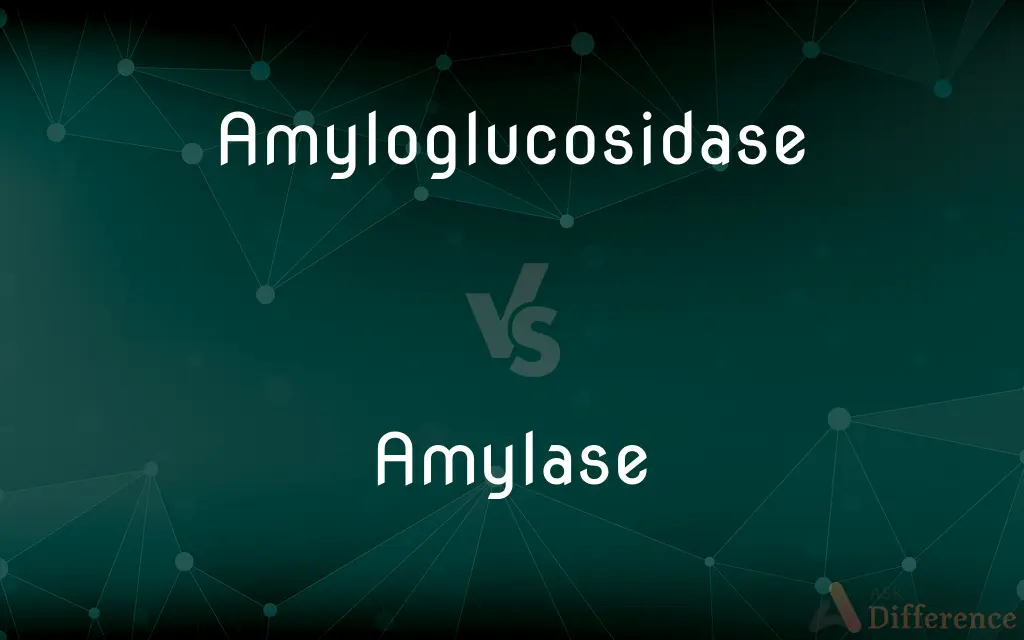Amyloglucosidase vs. Amylase — What's the Difference?
Edited by Tayyaba Rehman — By Urooj Arif — Updated on March 28, 2024
Amyloglucosidase breaks down starch into glucose, while amylase splits starch into maltose and dextrins, each serving distinct biochemical roles.

Difference Between Amyloglucosidase and Amylase
Table of Contents
ADVERTISEMENT
Key Differences
Amyloglucosidase is an enzyme that specifically targets the hydrolysis of glycosidic bonds in starch, resulting in the production of glucose. This enzyme is crucial in various industrial processes, including brewing and biofuel production. On the other hand, amylase is a more general class of enzyme that acts on starch to break it down into smaller sugar units like maltose and dextrins. Amylases play essential roles in the digestive systems of animals and in the germination of seeds.
Amyloglucosidase is highly efficient in converting starch into glucose, making it valuable in processes requiring high glucose yields, such as fermentation for ethanol production. Whereas, amylase, particularly alpha-amylase, initiates the breakdown of starch in the human digestive system and is also used in baking and brewing to convert starches into sugars that yeast can ferment.
The specificity of amyloglucosidase for the outer glucose units of starch molecules allows for complete starch degradation. This specificity is contrasted with amylase's broader activity range, which can act at random locations along the starch chain, leading to a variety of product sizes and compositions.
Amyloglucosidase requires an acidic environment to function optimally, often working best at a pH close to 4.5. Amylase, particularly salivary amylase, operates effectively in a neutral or slightly alkaline pH, more aligned with the conditions found in the human mouth and small intestine.
The application of amyloglucosidase in industrial settings emphasizes its role in producing high glucose concentrations from starch substrates, which is pivotal in manufacturing syrups and bioethanol. In contrast, amylase has widespread use in food processing, textile, and paper industries, highlighting its versatility in breaking down starches into various useful products.
ADVERTISEMENT
Comparison Chart
Primary Action
Breaks down starch into glucose.
Breaks down starch into maltose and dextrins.
Specificity
Highly specific to glycosidic bonds at the end of starch chains.
Acts on internal bonds within starch molecules, less specific.
Optimal pH
Functions best in acidic conditions, around pH 4.5.
Prefers neutral to slightly alkaline conditions.
Main Use
Used in biofuel production and brewing for high glucose yield.
Used in food processing, textile, and paper industries.
Source
Produced by certain microorganisms and fungi.
Found in saliva, pancreatic fluid, and plants.
Compare with Definitions
Amyloglucosidase
Derived from microbial or fungal origins.
Amyloglucosidase from Aspergillus niger is commonly used in industrial applications.
Amylase
Present in human saliva and pancreatic fluid, as well as in plants.
Salivary amylase starts the process of starch digestion in the mouth.
Amyloglucosidase
An enzyme that catalyzes the hydrolysis of starch into glucose.
Amyloglucosidase is used in the brewing industry to increase the glucose content of wort.
Amylase
Used in bread making to enhance fermentation.
Adding amylase to dough improves bread texture and rise.
Amyloglucosidase
Converts starch to glucose efficiently.
The high glucose yield in certain bioethanol processes is attributed to amyloglucosidase.
Amylase
An enzyme that breaks down starches into sugars like maltose.
Amylase activity is essential for the initial digestion of dietary starches.
Amyloglucosidase
Key in producing high-fructose corn syrup.
Amyloglucosidase's role in converting corn starch to syrup is critical in the food industry.
Amylase
Initiates starch degradation in various biological and industrial processes.
In the brewing industry, amylase helps convert grain starches into fermentable sugars.
Amyloglucosidase
Works best in acidic environments.
Adjusting the pH to 4.5 optimizes amyloglucosidase activity in starch processing.
Amylase
Effective in neutral to slightly alkaline pH levels.
Amylase in the small intestine continues starch breakdown in a mildly alkaline environment.
Amyloglucosidase
(enzyme) A form of amylase used industrially to produce sugars from starches
Amylase
An amylase () is an enzyme that catalyses the hydrolysis of starch (Latin amylum) into sugars. Amylase is present in the saliva of humans and some other mammals, where it begins the chemical process of digestion.
Amylase
Any of a group of enzymes that catalyze the hydrolysis of starch to sugars. In humans, amylases are produced in the salivary glands and the pancreas.
Amylase
(enzyme) Any of a class of digestive enzymes, present in saliva and also contributed to the gut by the exocrine pancreas, that break down complex carbohydrates such as starch into simpler sugars such as glucose.
Egg yolk amylase
Amylase
Any of a group of proteins found in saliva and pancreatic juice and parts of plants; help convert starch to sugar
Common Curiosities
Where is amylase found?
Amylase is found in human saliva and pancreatic fluid, as well as in plants.
How are amyloglucosidase and amylase different in their action on starch?
Amyloglucosidase breaks starch into glucose, while amylase produces maltose and dextrins.
What is amyloglucosidase?
Amyloglucosidase is an enzyme that hydrolyzes starch into glucose.
In what industries is amyloglucosidase primarily used?
It is used in brewing, biofuel production, and the manufacture of high-fructose corn syrup.
Can amylase produce glucose from starch?
Amylase breaks starch into maltose and dextrins, not directly into glucose.
What does amylase do?
Amylase catalyzes the breakdown of starch into smaller sugars, like maltose and dextrins.
What makes amyloglucosidase specific in its action?
It specifically targets the glycosidic bonds at the ends of starch chains.
What role does amylase play in the human digestive system?
It initiates the breakdown of starch into smaller sugars for easier digestion.
What are the key applications of amylase in industries?
Amylase is widely used in food processing, textile, and paper industries.
Why is amyloglucosidase important in biofuel production?
Its ability to efficiently convert starch into glucose makes it vital for ethanol fermentation.
How does the optimal pH for amyloglucosidase and amylase compare?
Amyloglucosidase works best in acidic conditions, while amylase prefers a neutral to slightly alkaline pH.
Is amyloglucosidase found in the human body?
No, amyloglucosidase is not naturally found in the human body; it is derived from microbial sources.
Share Your Discovery

Previous Comparison
Rope vs. Hawser
Next Comparison
Pillowslip vs. PillowcaseAuthor Spotlight
Written by
Urooj ArifUrooj is a skilled content writer at Ask Difference, known for her exceptional ability to simplify complex topics into engaging and informative content. With a passion for research and a flair for clear, concise writing, she consistently delivers articles that resonate with our diverse audience.
Edited by
Tayyaba RehmanTayyaba Rehman is a distinguished writer, currently serving as a primary contributor to askdifference.com. As a researcher in semantics and etymology, Tayyaba's passion for the complexity of languages and their distinctions has found a perfect home on the platform. Tayyaba delves into the intricacies of language, distinguishing between commonly confused words and phrases, thereby providing clarity for readers worldwide.















































